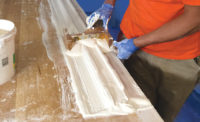For the past few years here at Walls & Ceilings magazine, we’ve been considering the fundamentals of traditional plasters. We began with the basics, explaining what makes something a plaster, where you might expect to find different plasters utilized, as well as the practical functions they perform in architecture. Next, we gave an overview of the few simple components making up traditional plasters, paying especially close attention to the chemistry and physical properties of the binders, the “mineral glue” that most influences how a plaster will perform.
Here we take it one step further by mixing things up a little, seeing what happens when we blend certain plaster binders together and identifying which plaster binders play nice together and a couple that are best avoided.
Explaining the Diagram
Years ago, when I was studying French plaster traditions in Paris, a local friend and colleague who is a manufacturer of heritage plasters sketched a little useful diagram on a napkin as he was explaining to me which plaster binders were chemically compatible with which. The diagram is used as a basic memory aid that I quickly learned all the plasterers trained with Les Compagnons (the traditional guild system in France) knew and seemed to almost take for granted.
The diagram is simply constructed as two triangles arranged back to back with a space separating them. Examining first the triangle at left, above it is clay, below it is lime, and to the far left of it is gypsum. The triangle indicates that any one of these binders may be mixed with any other or even all three together—there being no inherent chemical incompatibility. The triangle at right is similar. One can blend clay, lime and the family of hydraulic limes together without an adverse chemical reaction.
However, that is not the case for gypsum and hydraulic limes; they should never be mixed together directly, as they will quickly precipitate expanding salts, alternatively known as efflorescence. Hence, the reason for the separation space between triangles. There is one exception. Although hydraulic lime plasters should never be applied over gypsum, it is acceptable to apply gypsum plasters over hydraulic plasters if you wait a full 28 days for the hydraulic component of the lime to cure.
Even for the compatible binders, it’s best to keep in mind that just because you can blend them without creating an adverse chemical reaction, doesn’t mean you should, as not all blends are particularly interesting. That being said, some blends have proven to be extremely useful, extending the aesthetic and performance possibilities of a given plaster beyond any binder used in isolation. Let’s consider a few “classic” mixes.
Lime and Gauge
Lime plasters are really amazing. They’re the perfect combination of sticky and slick, and the easiest to work up to a perfectly smooth finish. These properties allow the plasterer to apply lime even to the most difficult surfaces such as ceilings with minimal effort. Lime plaster has a few major drawbacks however. They take a couple of weeks to cure, they always shrink and because of that, if you apply them even a little too thick, they’ll crack and potentially fail. Plasterers learned that they could “gauge,” that is add gypsum as a secondary ingredient to lime putty and the blended material was still lovely to work with but would set firm in minutes and resist shrinkage and cracking.
Stucco Forte
In Venice, they developed a tradition similar to lime and gauge but utilizing an opposite ratio; a lesser amount of lime and marble dust is added to a base of gypsum with a hide glue that retards the set. Because gypsum is self-binding, no aggregates are needed.
The lime makes the blend ductile, perfect for carving in situ and the addition of marble dust allows the blended plaster to be buffed to a high polish. The “stuccotori” expert Venetians of this medium and technique were highly pursued artisans who carried out grand commissions throughout Italy and eventually abroad to Germany, France and the United Kingdom. Local artisans learned the techniques of blending the plasters and methods of application, thus continuing the tradition for several generations.
Stabilized Earthen Plaster
Clay based materials such as adobe, cob, rammed earth and earthen plasters are very ecological and inexpensive, requiring no industrial processing and very little if any energy consumption. However, because they are more susceptible to erosion their use has either been limited to very dry climates or requires constrained designs with extended eaves to prevent streaming water. Blending a small percentage of natural hydraulic lime can go a long way in stabilizing an earthen plaster.
While the lime portion stabilizes the clay, the hydraulic component crystallizes around the aggregates. The result is an earthen plaster that retains much of the ecology and breathability typical of clays that can be used in almost any weather environment and with greater architectural liberty.
It’s not uncommon to encounter plasterers who claim to exclusively work with a gypsum, lime or earthen plaster, often making the argument that their plaster of choice is “superior” to the others for stated reasons. Nevertheless, these materials are not in competition, one is not better than the other. They simply have properties that can help us achieve a desired functional performance or aesthetic goal. Often times the best plaster for a given situation comes from a blend of plaster binders that has properties that any given plaster binder in isolation could ever hope to achieve. W&C








Report Abusive Comment